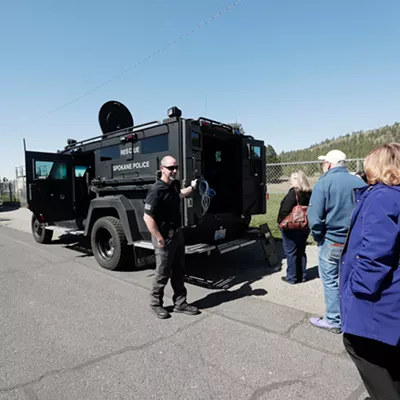Benites Sichiro and Otto Zehm are the first two people in Spokane to die shortly after being hit with a powerful electric charge from a Taser. Because of this tragic distinction, Sichiro and Zehm are now part of a growing list that tracks such deaths. The list, compiled by the Arizona Republic newspaper, is at the center of a national debate on the safety of Tasers and other stun guns.
The recent run of post-Taser deaths (there was also a runaway cow that died after being repeatedly Tasered by Spokane County sheriff's deputies) as well as the growing national debate may lead to a review of training, Taser deployment policy or oversight.
Last month, the Spokane Police Advisory Committee looked at Taser use by city police, and this week's meeting was scheduled to examine issues related to use of force by officers.
The meetings are to make advisory committee members more familiar with the issues in the wake of the two deaths, says Rick Mendoza, committee chairman. Mendoza adds that police here appear to use Tasers cautiously and professionally.
Two Deaths
The 39-year-old Sichiro died Jan. 29 after a series of fights with as many as eight corrections deputies at the Spokane County Jail. Deputies used Tasers three times as well as a variety of holds and knee strikes in the chaotic struggle to subdue Sichiro and move him closer to the nurse's station so his health could be monitored.
Sichiro had been booked into the jail two days earlier, his face already swollen from street fights. He was said to be going through alcohol withdrawal. An autopsy determined the cause of death to be a lacerated liver from blunt force trauma, and criminal charges may still be filed against some of the jail guards.
Zehm, a 36-year-old janitor with no criminal history, went into a coma and died two days after being confronted by police officers who had been called to a mini-mart on March 18 for a possible robbery. Zehm was said to be standing near an ATM machine and appeared suspicious to the person calling in the tip.
The developmentally disabled man became agitated when confronted by police; he was Tasered twice but subdued by a baton after the electric jolts appeared to have no effect.
The two Spokane deaths also fit a national profile of unarmed men who did not appear to be posing serious or imminent danger to the public. Jail guards used Tasers on Sichiro, who was already in custody in a controlled environment. Zehm fits an emerging profile of large men who are Tasered, restrained with hands and sometimes legs behind their backs and who then have difficulty breathing -- known as positional asphyxia.
Police are aware of positional asphyxia risks for large people, but it's not clear if Tasers, which disrupt muscle control, add to stress on heart and lungs.
Standard Uses
Terri Sloyer, staff attorney at the Center for Justice in Spokane, says it's time for a conversation on Taser use. She had already requested police Taser records even before the Sichiro and Zehm deaths. She was motivated by anecdotes about police using Tasers inappropriately. "Then the deaths occurred and [the records request] wasn't hypothetical any more. It was sadly real," Sloyer says. She has since been retained by Zehm's mother, Ann.
Sloyer says she has asked for use-of-force policies. "It seems to me you can use Tasers more frequently here than in L.A.," she says, citing the Los Angeles policy of someone "violently, aggressively resisting arrest" versus the local "assaultive behavior."
Assaultive behavior, says Det. Randy Lesser, SPD's Taser trainer, comes down to an officer's judgment call that a subject is ready to fight. It can be a person getting into an aggressive stance, verbal threats, clenched fists or a variety of other cues.
There are two ways to use a Taser -- by firing probes that deliver a shock via wires, or by removing the probe cartridge and touching the gun's electrodes directly onto a person's body. This latter is known as "drive stun."
Lesser says Spokane is far more restrictive than most area departments when it comes to use of the probes, partly because of the danger of hitting a person in the eye, genitals, neck or face and causing more severe injuries. The probes also cause more crippling pain because they are widely separated; as a result, a larger area of the body completes the electrical circuit, so to speak, and thus more muscles are incapacitated.
The drive-stun mode is lower on the use-of-force continuum and can be used more often, Lesser says, because the space between the contact points is so small, the effect -- while still painful -- is not as disabling. Officers are trained to avoid repeated use of Tasers if it appears to have no effect, Lesser says.
He says officers are also trained to make their move as soon as the Tasers are deployed. "When the electricity goes on, you usually have five seconds. When the electricity goes off" -- he snaps his fingers -- "they are back in the fight." If police don't move quickly, the subject is Tasered again, Lesser says. "We don't want a situation where somebody gets 30 seconds, 60 seconds, 90 seconds of electricity."
Sloyer says she is concerned Taser use may slide too far down the use-of-force continuum and be used too routinely for compliance purposes.
Tasers are supposed to be a step below using lethal force, she notes, "So I agree that they have saved lives, but if they are using Tasers where they are not justified, it's like instead of taking an aspirin because you have a headache, you take an aspirin so you don't get a headache."
Growing Controversy
Nationally, Amnesty International recently renewed a call to ban Taser use until more is known about safety. The group cited a spike in post-Taser deaths since one was recorded in 1999 and another in 2000. In 2001, there were four deaths, including a fetus.
In 2004, there were 56 such deaths. In 2005, there were 62.
It is estimated that 7,000 law enforcement agencies use Tasers.
After the Spokane Police Department purchased several Tasers in 2003, it became the first local agency to use them. SPD now has 192 of the weapons. In 2003, SPD deployed Tasers 94 times. That rose to 102 the next year but dropped by half -- to 55 -- in 2005, Spokane police records show.
The drop is likely due to two factors, Lesser says. Police, simply through use, become aware of situations where they are effective as well as where they just don't work very well.
Second, people on the street either have experienced a Taser shock or have heard stories. "People don't like electricity. Once they see the red dot on them, they don't want to experience a shock. They say 'OK, I give up,'" Lesser says.
"We are always looking for the perfect tool that prevents injuries and quickly controls somebody," Acting Chief Jim Nicks says. "One thing we have learned over and over is there is no perfect tool."
He says Tasers are the best tool city police have right now to control combative subjects.
Nicks also says police were called out on "citizen contacts" 143,324 times in 2005, with use of force 162 times. Tasers were used 55 of those times, and the probes (for assaultive behavior) were used only 27 times.
"That's really a pretty small percentage," Nicks says. "We are cautious about how we use Tasers."
Sloyer says concerns over Taser use on the mentally disabled -- who more frequently fill jails because social programs have been cut -- need to be addressed.
"What training do officers get to distinguish between, 'Am I in danger?' or, 'Does this require a mental health professional?'" she asks. "I don't want this to be us versus them. But how can we evolve as a community and be respectful and safe?"


















